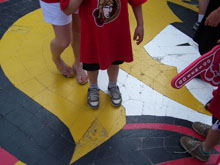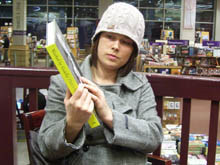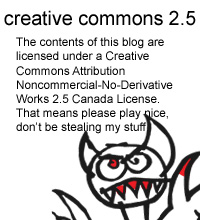

One of the easiest lies artists believe is “you need to use the Internet to sell yourself”… that, somehow, ‘the Internet’ will drag you up and out of obscurity, and bring you to a huge audience who will buy all of your work for top dollar and praise your brilliance in long articles in Rolling Stone magazine.
And it is, for the most part, a lie. Artists do survive just fine without having a web presence.
But there is some truth in there, and it mostly depends on what definition of ‘Internet’ you use. If you’re willing to learn how to use it, chances are the ‘Internet’ could (or should) be a really easy way to reach a larger audience for your work.
Most of us who have turned to the ‘Internet’ to market and sell our work have simply started ‘static web sites’ — places to store our archives. An address to put on business cards.
The problem with a static web site, of course, is there’s never a reason for anyone to go back (even if they look great, and showcase awesome art). At least not regularly. You hand me your card, I check out your site once or twice, I see the same material, I never come back — not because I don’t like you, but because… what’s the point?
There’s no sense of community. There’s no chance to build a community. There’s no opportunity for growth. There’s no interaction between us, or between myself and the other people looking at your work.
They have their uses, but ‘static web sites’ are extremely limited and limiting. If want to use the ‘Internet’ to market yourself, to promote your work, if you’re looking for interaction, a community, finding people with common interests, you need a ‘dynamic web site’.
You need something that changes, that can encourage discussion and can be frequently updated — Facebook, Twitter, a blog, Instagram… ask your kid for the other ones.
Because, no word of a lie, if you’re not using a dynamic web site to market and promote your work, you might as well be swimming up a waterfall… which can be a problem for a lot of us who never considered swimming lessons important to our art to begin with.
But it doesn’t have to be hard.
The biggest obstacle to using the Internet to create a community, to market our work, is mental… because the responsibilities can appear to be a full time job. But they’re not. At least they don’t have to be.
They can be fun and simple. Updating our ‘Official Arbor Gallery Facebook page‘ takes all of eight seconds per post, three to four times a week. That’s 90% of our entire communications strategy regarding Facebook.
Our ‘Official Blog’, for example, looks as though it is maintained by an infinite staff of highly alert, Red Bull-fueled monkey cyborgs. In fact I — a simple diabetic monkey going through ‘stage five renal failure’, with a newly pregnant wife, a needy cat, and two young children — write up all the posts, edit all of the photos, and publish everything in a (very relative) timely manner.
So far, preparing the average post on this blog takes a few hours out of my week.
But your ‘dynamic web site’ (re: blog) can be anything you want it to be… some of my favourite amateur bloggers simply post videos or photos a few times a week, with a few interesting bits of information regarding where they were, what they were doing, or the techniques they used.
Most of us cannot just step out the door and find five or ten people who can act as a mentor, or sit down and talk to for an hour about our shared interests, or collaborate with on a project.
This is where the Internet can offer us a community to learn from, to have fun with, to interact with.
I started my first blog in 2002 as a way to keep in touch with friends and family. In 2006 I stared a personal blog that brought me into a much larger community of people going through the same issues. Then there was a blog I started about Canada that’s still one of the most popular in Google searches (seriously, Google ‘Ten Things About Canada… it’s there).
This past summer I started a photo blog to showcase photos of Vankleek Hill’s people and events.
I met ‘The Idiot Photographer‘ when I started my own photo blog, and they instantly became one of my favourite artists. When I started a writers blog, I found an entire blogging community in Ottawa, a fantastic poet in Louisiana, a story teller living in Seattle, Washington, an entire writing community in the UK — I even found out there’s a large community of people who blog about knitting based in Ottawa.
Personally, I can’t knit, but I can see the appeal…
Writing about technology issues — Internet privacy issues, mostly — brought me into a larger community, including a social media expert in Vancouver, and technology reporter in India.
The main focus of this blog is to build a community. So what we’re going to do over the next few weeks is publish a series of tutorials on how to build, and maintain, your own online community… we’re going to look at everything from the cost of getting online; to what platforms you can use for your blog — using Facebook is a good start, for example, but is only good for marketing to other Facebook users; to how to edit photos; how to embed videos (how to make videos), and; even what the laws are regarding what you can write and post.
We’re going to discuss everything you can think of (at least, that we can think of) that will get your work digitized and noticed — including copyright issues and how to protect your material online and off.
And it’ll all be free. Because that’s how we roll.
![]()









 0_o
0_o





















Looking forward to learn.
Thanks for the comment, Denise, we’re looking forward to exchanging ideas and learning from you as well.
Great post. I look forward to the tutorials!
Thanks, Lesley, and thanks for the comment. The first thing we’ll be looking at is comparing the local Internet Service Providers — what speed and costs would be best, who they are, and how to test the lines to find out if you’re getting the best deal.
It should be up on Monday.
You’ve got some great work on your site, by the way.
Look forward to hearing more.
Thanks for coming over, Jacquie, and thanks for taking part in our ‘Got Art?’ program.
I suggest to use lookup.tools to get whois for all GTLD and CCTLD and also access to free Phone, NS, IP, Email address and owner reverse whois